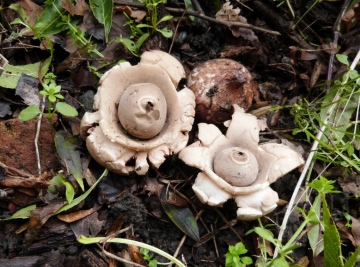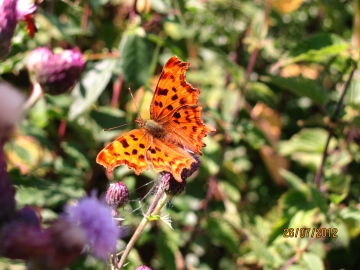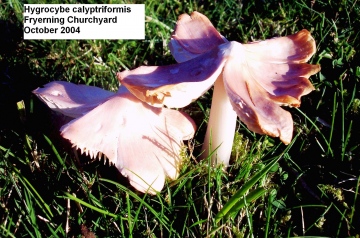The Club's Fungi Forays have now drawn to a close, the final one being the Waxcap Foray Last Saturday, November 2nd. It has been one of the best seasons for many years, the frequent rain and mild weather creating ideal conditions for them. Our opening foray in mid-September - to Monks Wood, Epping - produced 133 species including a number of rarities such as the aptly named Destroying Angel Amanita virosa, a pure white member of this dangerous group of fungi. Geoffrey Kibby, who was on the foray, had not seen it in the Forest for 45 years yet we found five of them in a few hours. None of the other forays quite matched this one but I was just as pleased with this Collared Earthstar, a much commoner species which we found during a visit to Warley Place EWT Reserve on October 29th.
One of the best ways to enjoy natural history is to potter. Potter about in the garden. Potter about in a wood. Potter along a seawall. Don't hurry. Take your time. See what comes along. On 30th I pottered about in Stoneymore Wood, Mill Green gathering chestnuts. There has been an absolutely massive crop this autumn, as with so many other berries and fruits. On second thoughts there may have only been a massive amount, or even or even just a large number............... Anyway, it was a beautiful October day - warm in the sun - and having collected my fill I sat on the bench overlooking the last remnant of heather grassland on the edge of the adjacent Common and enjoyed a leisurely lunch. Jays were constantly ferrying acorns between the wood and nearby pasture; a pair of Buzzards circled high overhead, their mewing calls reaching me faintly on the breeze; and a Comma butterfly came and joined me for a while in the sunsshine.
The Waxcap foray produced 8-10 species in each of the three sites we visited - Fryerning Churchyard, Chelmsford Crematorium and Little Leighs Churchyard - and 12 species in total. Waling around a churchyard in muddy boots and old clothes doesn't bother me but walking around a Crematorium makes me feel self-concious. There is no logic to it. Or is there?
This was the only locality where we found the beautiful Pink Waxcap, Hygrocybe calyptriformis, at least twenty specimens adorning the grass between the graves. After the foray was over we retired to Tony's house for our AGM and laid plans for the next season!


























